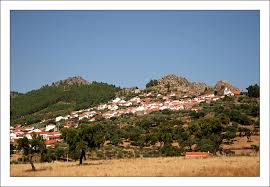Penha Garcia
Guardião da Penha

Penha Garcia localiza-se numa crista quartzítica a uma altitude de 480m.
O seu topónimo poderá estar relacionado com Dona Garcia Mendes, importante figura no início da nacionalidade.
Em 1220 D. Afonso II conquistou o território aos Mouros e doou-o à ordem de Santiago, estes deveriam construir uma fortaleza, neste território duplamente fronteiriço: com os Mulçumanos a Sul e o Reino de Leão e Castela a Este. Não tendo sido a fortaleza edificada, D. Afonso III retirou o território à Ordem em 1256.
D. Dinis decidiu doar a povoação à ordem dos Templários.
O pelourinho foi edificado durante o reinado de D. Sebastião em 1578, composto de 4 degraus, coluna e capitel jônico, com as armas reais e a inscrição do nome dos seus edificadores: Esteves Simão e Domingos Fernandes. Termina com uma peça cônica e catavento em ferro.
A partir do Século XVII passou a fazer parte da Comenda dos Condes de São Vicente da Beira.
O concelho é extinto em 1836.

O Guardião
A junta de freguesia pediu ao exército português que se cedesse um avião para servir de complemento ao parque infantil anexo, mas como não havia um avião disponível veio um tanque de guerra...
Trata-se de um carro de combate M-47 Patton, chegaram ao país em 1952 sendo recebidas cerca de 150 unidades.
Quando da eclosão da Revolução dos Cravos (25 de abril de 1974), estes blindados assumiram posições nas entradas da cidade de Lisboa e na Rua do Arsenal. Estiveram ao serviço do exército português até que começaram a ser retirados em 1978.
Características:
Fabricante: Detroit Tank Factory - Estados Unidos da América
Tripulação: 5
Comprimento: 6.307 m - Incluindo canhão: 8.508 m - Largura: 3.016 m - Altura: 3.352 m
Peso vazio: 42.130Kg. - Peso preparado para combate: 46.170Kg.
Sistema de tracção: Lagartas
Motor: Continental AV1790-5B V-12 Potência: 810 cv
Velocidade máxima: 48 Km/h - Velocidade em terreno irregular: 30 Km/h
Tanque de combustível: 875 Litros
Autonomia máxima: 130 km
Total de M47 construídos: 8676
A insólita presença de um carro de combate, numa aldeia com características medievais, não é de todo consensual. Por isso vai ser enquadrado numa instalação escultórica que homenageia os combatentes locais, em particular os da Guerra do Ultramar. O projecto está a ser concebido pela escultora Ana Mena, natural de Lisboa, mas com raízes em Penha Garcia. Incluirá 4 figuras humanas (uma representando os combatentes de Penha Garcia que perderam a vida na guerra e as restantes três uma família de turistas). As figuras serão pintadas de vermelho, simbolizando o “sangue derramado” na Guerra do Ultramar, mas também os cravos emblemáticos do 25 de Abril.
The Guardian of Penha
Penha Garcia is located on a quartz ridge, at an altitude of 480m.
Its name may be related to Dona Garcia Mendes , a major figure in the early nationality.
In 1220 King Afonso II conquered the territory from the Moors and donated it to the Order of Santiago, they should build a fortress in this double border territory: Muslim in the south and the Kingdom of Leon and Castile in the east. Not having been built fortress, D. Afonso III withdrew its territory from the Order in 1256.
King Dinis decided to donate the settlement to the Knights Templar.
The pillory was built during the reign of King Sebastian in 1578, composed of 4 steps and Ionic column, with the royal arms and the inscription of the name of their builders: Esteves Simão and Domingos Fernandes. It ends with a conical piece and iron weathervane.
From the seventeenth century became part of the domain of the Counts of São Vicente da Beira.
The municipality was abolished in 1836.
The Guardian
The parish council has asked the Portuguese army for a plane to serve as a supplement to Annex playground, but as there was no available plane it came a war tank...
This is a tank M -47 Patton, about 150 units arrived in the country in 1952.
When the outbreak of the Carnation Revolution (April 25th, 1974), these tanks took up positions at the entrances of the city of Lisbon and Arsenal Street . They were in use of the Portuguese army until 1978.
Characteristics:
Manufacturer: Detroit Tank Factory - United States
Crew: 5
Length: 6,307 m - Including Cannon: 8.508 m - Width: 3.016 m - Height: 3.352 m
Empty weight: 42.130Kg. - Embattled Weight: 46.170Kg.
Motor / power / capacity
Engine: Continental AV1790 - 5B V -12 Power: 810 hp
Max speed: 48 Km/h - speed over rough terrain: 30 Km/h
Fuel tank: 875 Litres
Self-sufficiency: 130Km
Total of M47 constructed: 8676
The unusual presence of a war tank, in a village with medieval characteristics is not entirely consensual.
So it will be in the future part of a memorial that honours local soldier, in particularly those who fought in the Colonial War in Africa. The project is being designed by Ana Mena , born in Lisbon , but with ancestry in Penha Garcia . It will include 4 human figures (one representing the combatants of Penha Garcia who lost their lives in the war and the remaining three a family of tourist). The figures are painted red, symbolizing the “bloodshed” in the Colonial War, but al